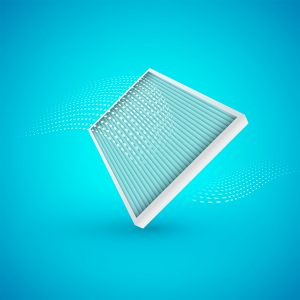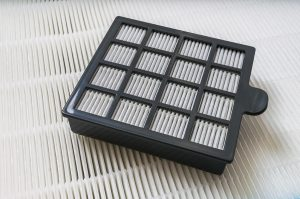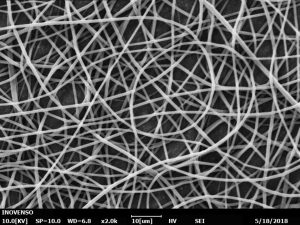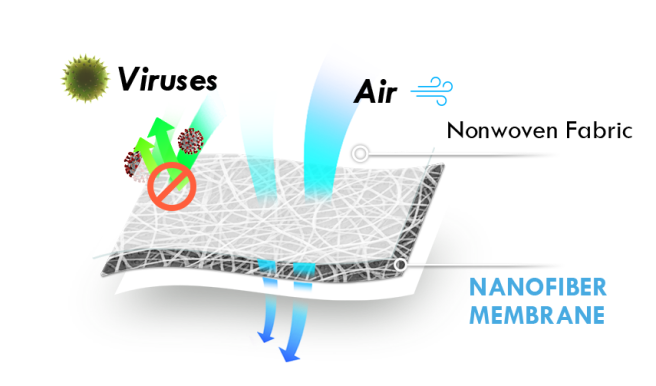© Copyright 2020 Foshan Membrane Technology Co., Ltd. All rights reserved. Sitemap
The goal of filters is to act as a sieve, to maintain or purify the quality of a medium. An air filter’s purpose is to purify or clean the medium that is air, by filtering out the unwanted pollutants present in the atmosphere. Air filters can be physically described as membranes that have a functional layer that can trap contaminating particles that were present in the air stream and prevent them from continuing. This functional layer can either be an electrostatic precipitator or nanofiber mesh.
Types of Air Filters:
Air filters come in various sizes and shapes tailored for a specific use. Panel-shaped air filters are often used in Heating, Ventilating, and Air Conditioning (HVAC) systems, where-as you may find cone shaped filters being used in automobiles. The list below gives more specific examples of the type of air filters commonly used in different areas:
Basic Air Filters: Specifically, for coarse particles (sand, hair), can be used for windows.

Advanced Air Filters: Capturing finer particles such as bacteria, can be used HVACs systems and portable air cleaners.
HEPA/ULPA: Highly efficient particle arrestors/Ultra-low penetrating air, similar to advanced filters but ensure at least a 99.97% filtration efficiency. Used in cleans room
and hospitals

N95/N99 Filters: Filtration media for face pieces. These are used for N95 and N99 face masks to prevent contaminants from entering the respiratory system.

Standardization:
To attain the label of an air filter, standards are to be met. These standards are often containing strict requirements that need to be passed for qualification. Standards and criteria vary from region to region. However, the two most pertinent parameters you will mostly find are the filtration efficiency and pressure drop. Ideally, a filter with the highest filtration efficiency and lowest the pressure drop is the most desirable. The following are a couple examples of international standardized tests (ISO) and their equivalent USA(ASHRAE/NIOSH) and European (EN) counterparts.

EN 779: The standard for basic to advanced fine air filters. (Now defunct and replaced by ISO 16890).
ISO 16890: The international variant for basic and advanced air filters.
ASHRAE 52.2: The North American variant for air filters that grade filters with a minimum efficiency reporting value (MERV). The highest MERV rating (16) indicates HEPA status.
EN 1822/ ISO 29463: Both the European and International tests for HEPA/ULPA filters.
EN 143/149: European Standards for mask filter media and mask products.
Mechanisms for Air filtration: Electrostatically charged Microfibers or Electrospun Nanofibers?
As mentioned prior, air filtering media has a functional layer that is responsible for capturing unwanted particulate matter (PM). The media can either entrap PMs due to electrostatic attraction as charged synthetic fibers that are either melt blown microfibers or pultruded glass microfibers, or mechanically capture them with electrospun nanofiber layers. While electrostatic media has been used to make air filters in the past, nanofiber media is the next generation technology for such filters. In fact, nanofiber filters possess a handful of advantages over the conventional meltblown and silica glass fibers.
Advantages of electrospun nanofiber filter media over conventional media:
(1) Advanced Fiber Filtration
Nanofibers have smaller fiber diameters than conventional filters. This allows the nanofibers to physically stop PMs from the air stream with out the need of electrostatic attraction. Due to small fibers, nanofiber meshes tend to have very high filtration efficiency.
(2) Lower Pressure Drop (Surface/Depth Loading)
Nanofiber filters usually have thin nanofiber layers on top of supporting substrates. This allows all the dust and contaminants to accumulate on the surface over time. This is known as surface loading, and the contaminating layer can be cleaned easily. This is not true for conventional filters, where over time, the particles penetrate deep into the filtering media causing blockage. As a result, there will be more pressure drop in these types of filters. This is known as depth loading.
(3)Energy Efficient
As a subsequent consequence of the previous benefit, since there is low pressure drop and little blockage over time, the nanofiber filters will require less energy for the air to ventilate through them. Thus being energy efficient for HVAC system buildings.
(4) Longer Filter Life
Surface loading implies that the filter needs to be cleaned from only surface. This is easily achieved in the HVAC with backwards pulses, where depth-loaded filters need to discarded after a time. This is because there is no efficient way to remove the particles that seeped into the filter. Hence, nanofiber filters have longer filter life.
(5) Cost-Efficient
Direct consequence of being energy efficient and having longer filter life. Nanofiber filters are cost-efficient as they last longer and do not need higher powered ventilation systems for circulating air.
(6)Customization (Modifications)
Electrospun nanofibers can be customized to have additional properties. They can either be post-treated or electrospun differently. Adaptable properties, such as modifying electrospun filtration membranes to remove VOCs at a faster rate than the conventional carbon filters (Scholten, E., Bromberg. L). Nanofiber membranes can be post-treated with Ag particles to add anti-microbial and viricidal properties so that the viruses and bacteria are captured and then killed (Ramakrishna).
(7)Environmentally Friendly
Electrospun polymers that are biodegradable can be used as filters and be environmentally friendly. The standard Glass fibers are not eco-friendly as after use, they are both difficult to recycle (Mechanical Recycling) and dispose of (Thermal Incineration). Both of which is costly and requires high energy.
Please check out Inovenso’s latest article written by our R&D team; “Electrospun Nanofibers for Highly Efficient Air Filter Applications” to get more detailed informations.
WHAT ARE NANOFIBERS?

Nanofibers capture particles mechanically unlike the conventional electrostatic filters. They are small and lightweight but give high filtration efficiency while maintaining low pressure drop. The interesting thing is that they are versatile and can be post-treated to have additional properties like potential antimicrobial layers and other multi-functions. Filter media made of nanofiber enable new levels of filtration performance for several applications ranging from industrial, medical and consumer as well as filtration processes required in defence application.
Advantages of Nanofibers
High volume filtration effectiveness in air or liquids
The channel is not made of paper so when dampness is available, the channel does not assimilate the build up
High twisting execution
Low weight drop, introductory, tireless and vitality cost
Ability to control pore measure in non-woven textures
Holds-up to sand and salt
Inovenso Technology provides services related to the electrospinning technology to accelerate the clients’ projects or tasks and aims to solve their problems as quickly and cost-efficiently as possible. With Inovenso’s 12 years practical experience in nanofibers and extensive knowledge in nanotechnology, you can produce your own nanofiber based filters!
Inovenso offers a wide range of nanofiber-based products for air filtration, and also the opportunity of developing custom-made air filters, that comply with the North American Standards for fine and ultra-fine filters such as ISO 29463 and with MERV classifications but also produces and contract manufacture Nanofiber Filtration Media that complies with N95/N99 standards with a high filtration efficiency and a low pressure drop.
At Inovenso, we have developed a patented “Hybrid Electrospinning” technology suitable for the production of Nanofiber Air filters with high filtration efficiency and low pressure rate.(ARTICLE)

Why Nanofiber Based Filter Is Worth To Have ?
Higher initial and ongoing efficiency
Lower pressure drop across the filtration media saves energy
Longer filter life
Less compressed air consumption required for pulse-jet cleaned dust collection systems
Flexibility in filter configuration to help solve problems
Article Source:https://www.inovenso.com/air-filters-with-nanofiber-technology/